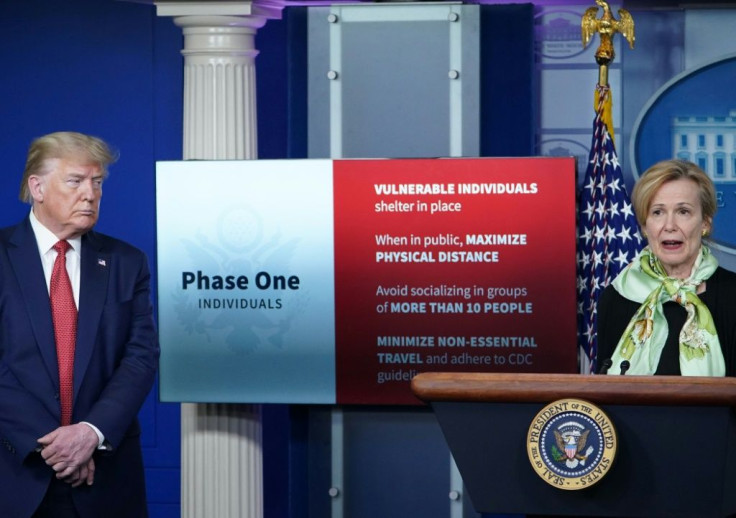Coronavirus US Death Toll Hits 34,580; Trump Reveals Plan To 'Opening Up America Again'

KEY POINTS
- President Donald Trump announces guidelines for his "Opening Up America Again" plan
- The plan is divided into three phases
- Each of the three phases consists of a set of recommendations for individuals and employers
The “Opening Up America Again” guidelines revealed by President Donald Trump Thursday enumerates hard-to-meet criteria that must first be satisfied before states can allow businesses to reopen and individuals to mingle freely among each other. It will open the door to the post-COVID "altered reality" where the need for human closeness is replaced by the medical imperative to stay safe by staying distant.
It comes at a time when the United States for the second straight day reported more than 29,000 new cases and the second straight day where it reported 2,000 new deaths -- which are both record highs. Total U.S. cases as of 23:30 GMT Thursday came to 677,056, an increase of 29,053 from Wednesday, according to Worldometer data. Cases on Wednesday were 30,342 larger than Tuesday's. Deaths from COVID-19 Thursday amounted to 34,580, which was 2,137 larger than Wednesday. There were 2,618 new deaths in Wednesday's total of 32,443 compared to Tuesday's total.
The 18-page "Opening Up America Again" plan also leaves to state governors the decision to lift social distancing and lockdown restrictions forced upon them by the COVID-19 pandemic. Trump has falsely claimed he has the "total authority" to reopen states for business. Legal experts blasted Trump's claim of total power as false because the federal government can’t override state-issued public health rules as upheld in several court rulings.
Trump says as many as 29 states “will be able to open relatively soon,” but didn't name the states. He said there are "a lot of states that, through location, through luck and also through a lot of talent ... are in a very good position.” He, however, didn't give any specific dates when these 29 states can reopen.
This outcome now depends on states meeting the “Opening Up America Again” guidelines for individual Americans and employers and its tough set of "gating criteria" that will be the key to proceeding to the next stages. The guidelines list down three interlinked phases where one must be fulfilled before proceeding to the next phase.
Each of the three phases consists of a set of recommendations for individuals and employers that are interlinked in a chain. Phases will be implementable statewide or county-by-county at the governors’ discretion.
The administration's "Proposed Phase Approach" intends to mitigate the risk of resurgence and protect the most vulnerable (the elderly, especially those with underlying conditions such as diabetes and cancer).
Phase one gating criteria for all vulnerable individuals means these people should continue to shelter in place. Precautions should be taken to isolate other people from vulnerable residents. Phase one also recommends all individuals, when in public, should maximize physical distance from others. It says social settings of more than 10 people should be avoided unless precautionary measures are observed.
For employers, phase one recommends they continue to encourage telework, whenever possible and feasible. If possible, employers are urged return to work in phases. They're also urged to close common areas such as canteens where employees are likely to congregate and interact. Strict social distancing protocols must be enforced.
Phase two for states and regions with no evidence of a rebound and which satisfy gating criteria a second time means all vulnerable individuals should continue to shelter in place. Members of households with vulnerable residents should be aware that by returning to work or other environments where distancing is not practical, they might carry the virus back home. Precautions must be taken to isolate these people from vulnerable residents.
For employers, phase two means continuing to encourage telework, whenever possible and feasible. Common areas where personnel are likely to congregate and interact will remain closed. Non-essential travel can resume.
Phase three for states and regions with no evidence of a rebound and which satisfy the gating criteria a third time means vulnerable individuals can resume public interactions. Vulnerable individuals, however, should keep practicing physical distancing and minimize exposure to social settings where distancing may not be practical. Low-risk populations should consider minimizing time spent in crowded environments.
For employers, phase three will see them fully reopen for business with unrestricted staffing at worksites.
© Copyright IBTimes 2025. All rights reserved.





















